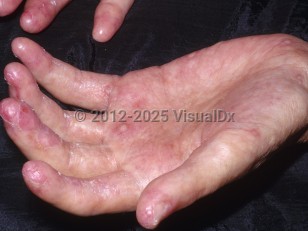Graft-versus-host disease (GVHD) refers to multiorgan dysfunction resulting from attack of an immunologically deficient host by foreign immunocompetent lymphocytes or bone marrow tissue (the graft). Most GVHD occurs in individuals who have undergone allogeneic bone marrow transplants, but it may occur in solid organ transplant and blood transfusion recipients.
Chronic GVHD most commonly affects the following organ systems:
- Skin (77%-100%): oral mucosa (16%-55%), ocular mucosa (12%-46%), and genital skin (2%)
- Lungs (11%-47%)
- Gastrointestinal (GI) tract (24%-47%)
- Liver (20%-38%)
- Peripheral nervous and musculoskeletal systems (0%-6%)
Multiple nail findings can be seen in both the acute and chronic forms of GVHD; findings in the chronic form are more common.
Acute GVHD is associated with periungual erythema or a violaceous hue of the surrounding tissues;
onychomadesis is also possible. Nail alterations occur in 17%-63% of patients with chronic GVHD, and other skin findings are commonly seen. Nail changes in chronic GVHD usually involve scarring of the nail bed and matrix. Fingernails and toenails may both be affected, but fingernails are affected more often. The most common nail finding is longitudinal ridging with nail alterations typically resembling the nail changes seen in
lichen planus.
Most studies show that the presence or absence of nail alterations is not predicted by the clinical severity of GVHD in the adult population. However, a higher incidence and severity of nail changes has been reported to occur in patients with a longer duration of disease. Nail changes are not considered when staging or grading GVHD. In one study, patients with chronic GVHD with hair and nail changes were significantly more likely to have involvement of the oral mucosa and eyes compared to controls.
The presence of nail dystrophy is associated with lower quality of life and higher overall severity of the disease in the pediatric population in one study.



